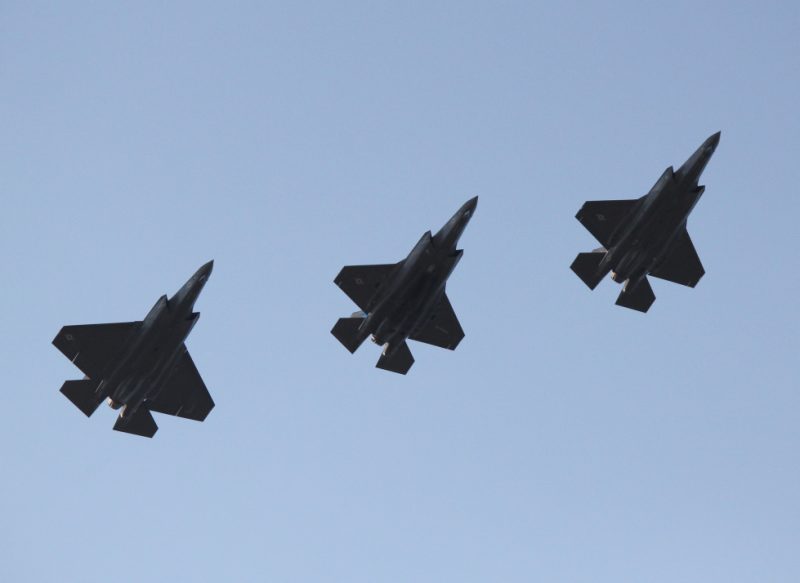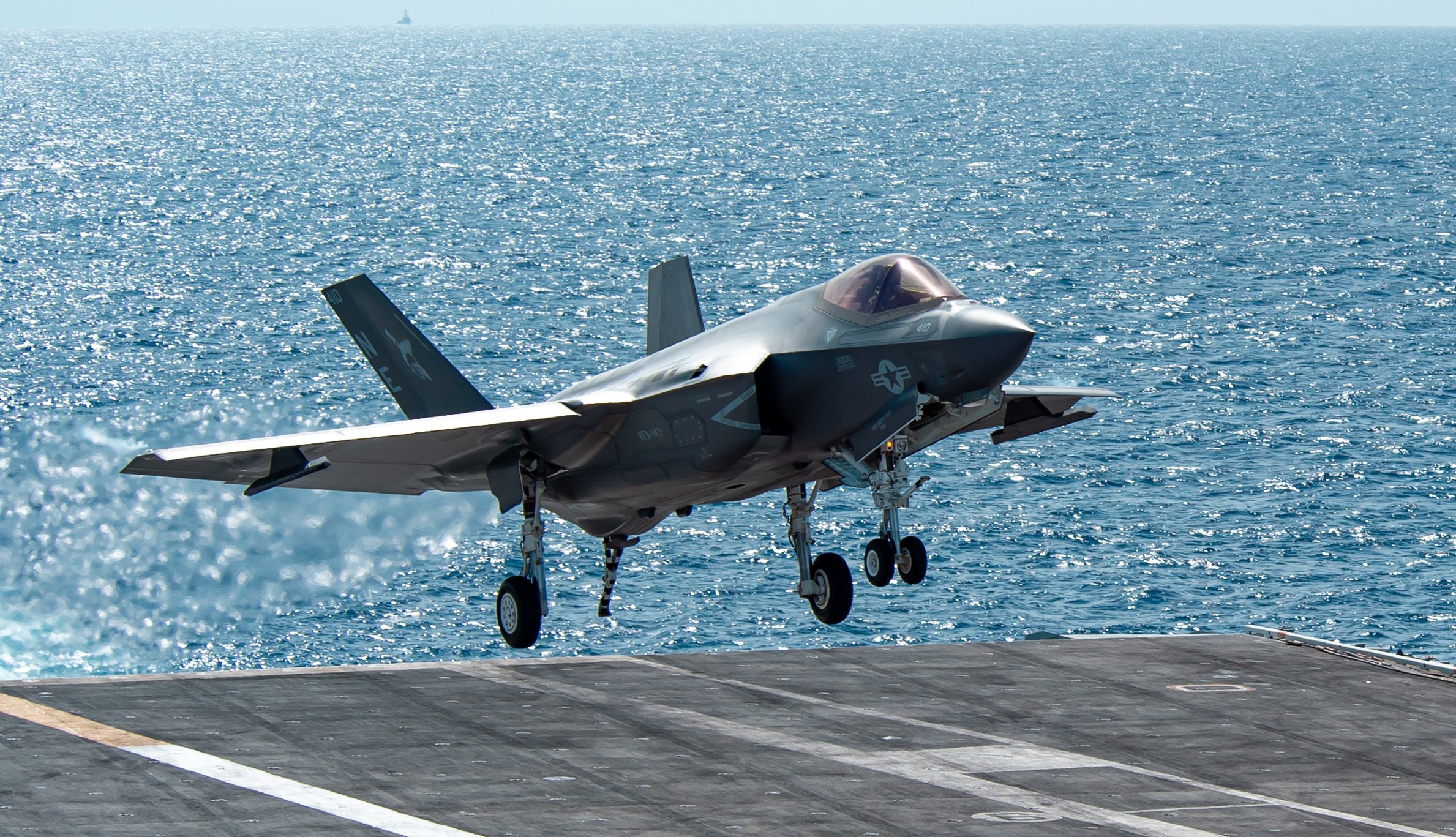The US’ ‘top fighter’ F-35 stealth jet has suffered a series of unusual crashes, raising questions about America’s most advanced combat jet. In January this year, it was the first time that an F-35C, the carrier variant of the aircraft, crashed at the ‘enemy’s doorstep’ — into the South China Sea.
Denied F-35 Stealth Jets, UK Comes To Turkey’s Aid After US Removed Ankara From Joint Strike Fighter Program
The wreckage of the aircraft was recovered from the bottom of the sea, about 12,400 feet below the surface, by a team made up of divers from the US Navy’s 7th Fleet Task Force and a Navy salvage and diving team, according to a press release.
The team used a remotely operated vehicle to retrieve the wreckage, which was finally pulled out by a crane attached to the Picasso ship. Chinese state media claimed the Picasso is a Chinese-built and Singaporean-operated ship, according to Hong Kong-based South China Morning Post.
U.S. 7th Fleet & Naval Sea Systems Command successfully retrieved the F-35 fighter jet that crashed 37 days ago in the South China Sea. The wreckage was recovered from a depth ~12,400 ft., following fears that it could end up in the hands of the Chinese military. pic.twitter.com/9HCof1TVfn
— W.J. Hennigan (@wjhenn) March 3, 2022
According to the report, the Picasso was built by China Merchants Heavy Industries, one of the top three state-owned shipbuilders, and is owned and operated by Ultra Deep Solutions (UDS), a Singapore-based deep-diving heavy construction vessel operator.
A US Navy F-35C had a “landing issue” on the deck of the Carl Vinson aircraft carrier in the South China Sea in January. The pilot ejected successfully, but seven US military men were reportedly injured in the incident reported on January 24. This was the third accident involving the F-35 in the past six months.

However, this crash assumed significance for its location — the hotly contested South China Sea where the US Navy’s 7th fleet often carries out Freedom of Navigation Operations (FONOPs), much to China’s discomfiture. It is noteworthy that China claims almost the entire South China Sea and remains locked in territorial disputes with many ASEAN countries.
From Artificial Sun To Orbital Bombardment Concept – China Claims ‘Big Breakthrough’ With Nuclear Fusion Reactor
Did Chinese-Built Ship Retrieve US Jet?
DSCVs (Diving Support Construction Vessel) are specialized vessels used for deep-sea salvage, installation, inspection, and repair. The Picasso is one of the most advanced DSCVs, having a Curv-21 remotely operated vehicle capable of diving to depths of over 3,000 meters.
The Curv-21 installed special rigging and lift lines to the F-35C Lightning II during its salvage mission last week.

According to the Seventh Fleet, the crane’s lifting hook was then lowered to the seafloor and attached to the rigging, and the aircraft was hauled to the surface, onboard the Picasso.
DSCVs built in China were previously used to recover aircraft from the seabed. The Van Gogh, another DSCV from the Singaporean corporation, was also involved in the salvage mission when an F-35A from the Japan Air Self-Defense Force fell into the Pacific Ocean in 2019.
The contracted multipurpose diving support and construction vessel DSCV Van Gogh departed Okinawa Wednesday with a #USNavy salvage team, a towed pinger locator (TPL) 25 system and remotely operated vehicles aboard. https://t.co/A95KOQTdR4
— U.S. Pacific Fleet (@USPacificFleet) April 25, 2019
According to the state-run Chinese newspaper Global Times, the Van Gogh was also built by CMHI and is one of five Chinese-built vessels managed by UDS.
Song Zhongping, a Chinese military analyst, said China is a world leader in shipbuilding, so it’s no surprise that Chinese ships were involved in the mission. “This shows the need for cooperation between the US and China,” he noted.
Military Experts Mock Chinese ‘Low-Quality’ Hardware For Russia’s Sluggish Progress To Sweep Ukraine, Seize Kiev
It is quite interesting that a Chinese vessel was used to retrieve a crashed fighter jet of the US military at a time when the two countries are at loggerheads in the Indo-Pacific region.
The wreckage was discovered in the northern South China Sea, around 300 kilometers (185 miles) west of the Philippines and 565 kilometers east of the disputed Paracel Islands (Xisha Islands).
Chinese underwater drones in the South China Sea to locate the sunken F-35, and likely salvage the wreckage in the shallow waters and capture US stealth and communication encryption technology. – Boz Military Research Institute pic.twitter.com/f6gWkRG3xZ
— Sk Boz, PhD ? (@skbozphd) January 25, 2022
Given the crash’s critical location, there had been concern that the Chinese military may attempt to collect the wreckage. Previously, in November last year, a British Royal Air Force F-35B had crashed from the Queen Elizabeth aircraft carrier into the Mediterranean Sea. At the time, the West was concerned about a possible Russian theft of the F-35 stealth technology.

The salvage operation for the F-35C began several days after the collision, and the 7th Fleet said it demonstrated the US Navy’s dedication to its assets as well as a free and open Indo-Pacific.
DSCV Picasso
PICASSO is an advanced DSCV designed and built for deep water deployment worldwide, according to Ultra Deep Solutions.
Fake News! Poland Slams US Reports As ‘Misinformation’; Says No Fighter Jets For Ukraine But Ready To Help Refugees
The vessel is equipped with 140t offshore cranes, diesel-electric frequency controlled propulsion, extremely efficient azimuth thrusters, a dynamic positioning system, and a diesel-electric frequency controlled propulsion (3,000m water depth).
A huge platform deck with an area of 1,300 m2 is ideal for wellhead servicing, inspection and construction diving. The vessel can carry up to 130 people. It was mobilized to perform deep-dive trials off Hong Kong in January 2018.
The Chinese state media projecting a vessel manufactured in its country as the centerpiece of the US salvage operation could be indicative of its willingness to engage with the US.
- Contact the author at sakshi.tiwari9555@gmail.com
- Follow EurAsian Times on Google News




